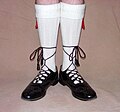lacing
Under lacing means a Verschließmethode, mostly of clothing, by means of a through eyelets drawn or holes cord.
principle
Two opposite edges of the garment are connected by the running cord, basically roughly sewn . Both parts are pulled together by pulling on the ends of the cord, then the lacing is fixed by knotting the ends of the cord. The bow is popular as a firm and at the same time easily detachable knot .
In contrast to other fastening methods ( buttons , zip fasteners ), the tensile force exerted on the ends of the cord is multiplied by the course of the cord ( pulley principle ), so that an extremely tight fastening is also possible. Whilst a point-like pull between two hooks is sought in a pulley block, in a lacing the tensile force is distributed over several points of application on the opposite, long "perforated edge strips".
Due to the friction on eyelets, hooks, holes, loops or fabrics, a great deal of force may be required when pulling the cord tight if there are a large number of deflections.
application
For the releasable closure of items of clothing and to connect two items of clothing, so-called nesting tapes were previously used. This type of closure was also known as "nibble". The ends of the nesting strips were often provided with metal sleeves, the so-called "nesting tips", in order to be able to guide them more easily through the holes or eyelets .
Nowadays, lacing is mainly used to fasten shoes ( laces ), for connections to body-shaping garments that have to withstand great tensile force, such as corsets , as well as in traditional costumes , traditional clothing and other outerwear to set visual accents.
In addition to clothing, the lacing was used to close leather footballs, for example.
Lacing on a Brogue -Schuh
Lacing methods
The course that the cord takes through the individual eyelets is not fixed, numerous variations are possible. When choosing the appropriate lacing method, especially for shoes, various aspects must be taken into account:
- traction
- The tensile force to be used to achieve a certain locking force can be very different, for example greatly increased when frictional forces have to be overcome or a largely longitudinal piece of cord only contributes a small force component to the locking force. On the other hand, it is a sometimes desired effect of inefficient lacing that it does not come off so easily even without fixation.
- Comfort
- A tight lacing with a thick cord can lead to pressure points. This can be aggravated or mitigated by the type of lacing. With certain lacing methods you can also achieve different tightly laced zones.
- symmetry
- Asymmetrical lacing usually has the disadvantage that the cord ends have different lengths after several closing and opening processes.
- aesthetics
- A regular, simple appearance of the lacing, but also the concealment of the pieces of cord on the underside, is perceived as particularly aesthetically pleasing. For different shoes or items of clothing, however, there are often different lacing methods that are considered particularly suitable (e.g. sporty or elegant variants). There are also regular decorative lacing, possibly with different colors, which serve more visual than practical purposes.
- simplicity
- If the amount of work involved in lacing is important (e.g. in shoe stores), simple lacing is preferred. The lacing of shoes is also a particular problem for people who can only use one hand for it. There are also special lacing methods for these purposes. (One-hand lacing)
literature
- Ian Fieggen, Laces, 100 s of ways to pimp your kicks , Sterling Publishing Co., Inc. NY., 2007 ISBN 1-4027-5201-6 .
Web links
- Articles for lacing shoes
- Many variations of the lacing of shoes (English)
- Marathon lacing for optimal hold when tying running shoes
- Lacing Instructions - Corset
- One-sided lacing on an orthopedic corset












